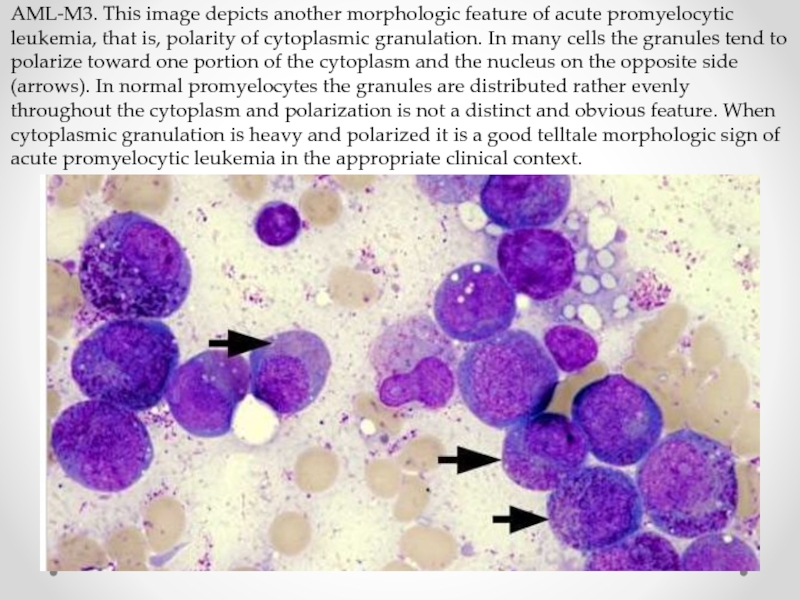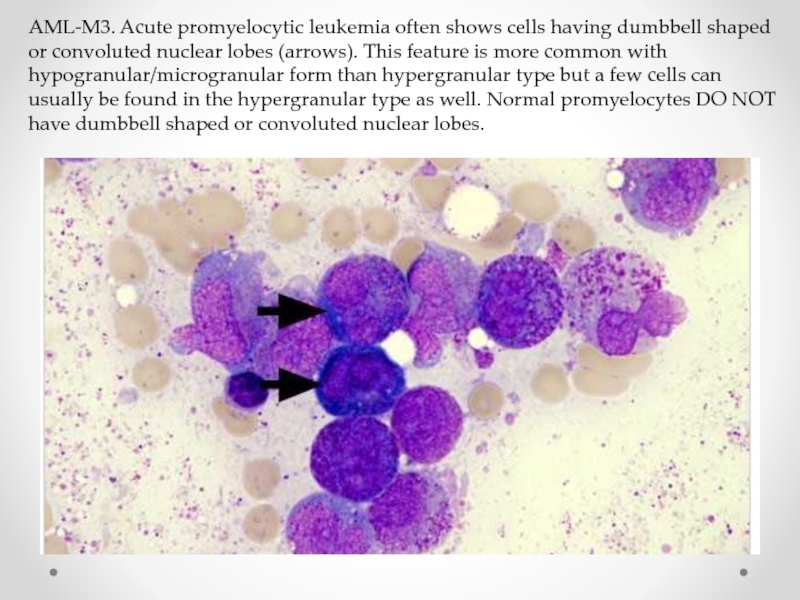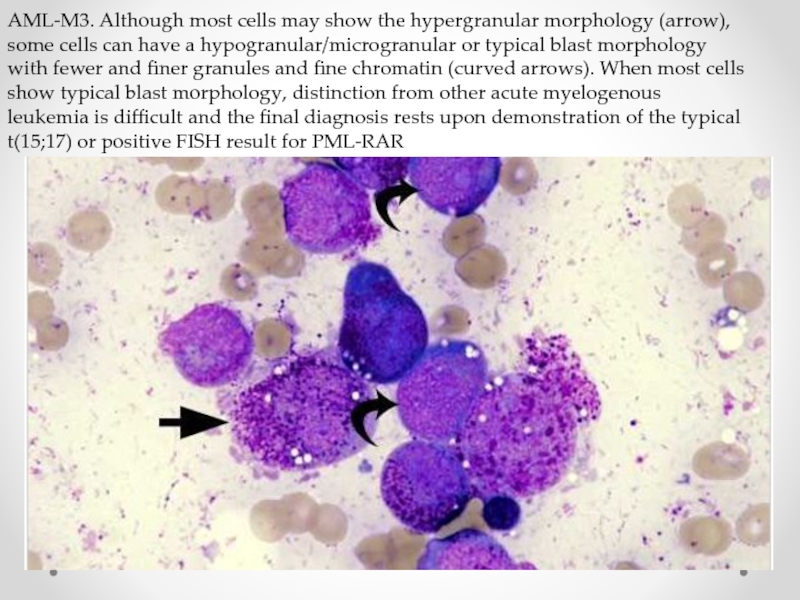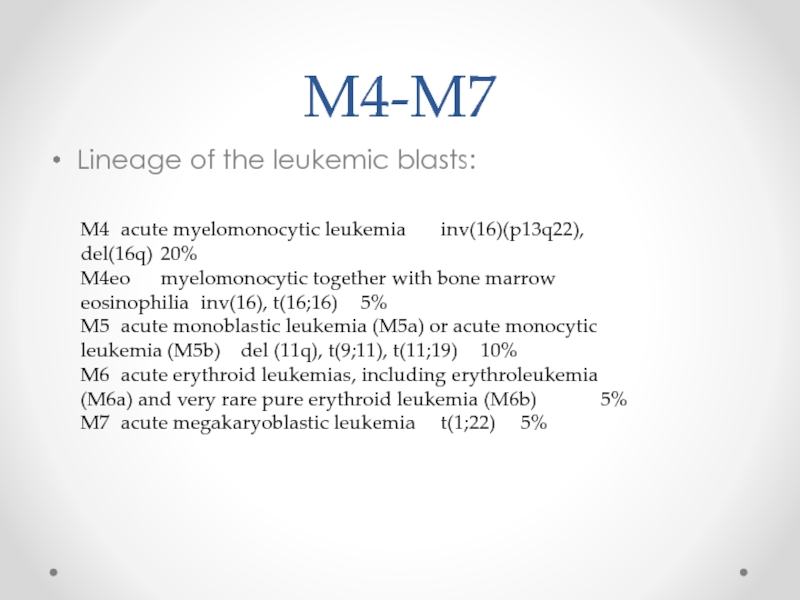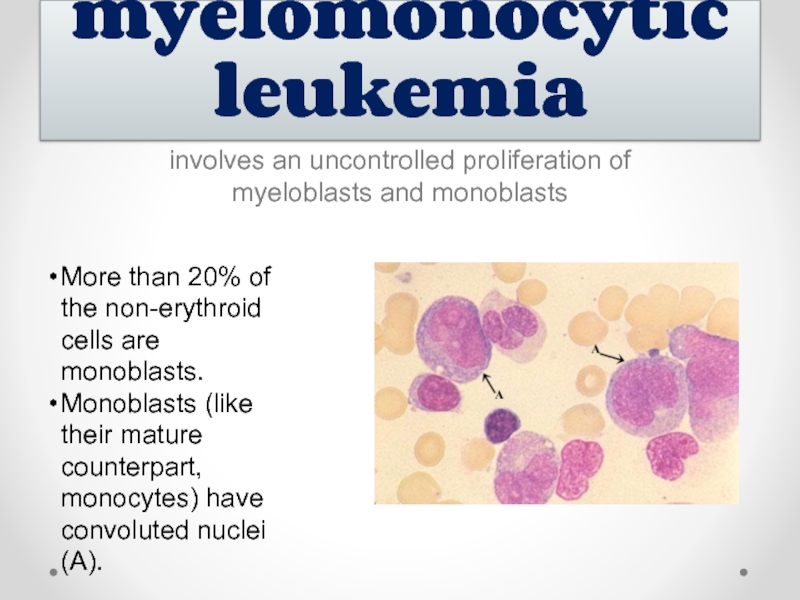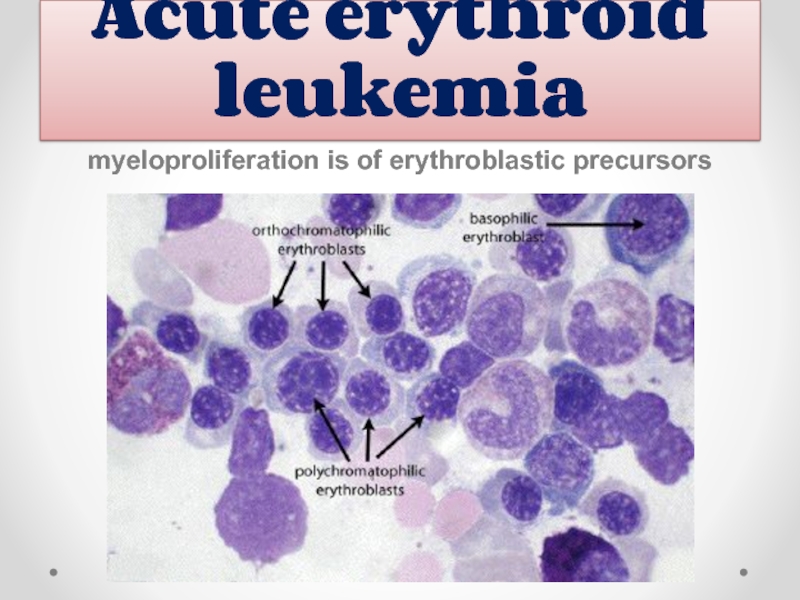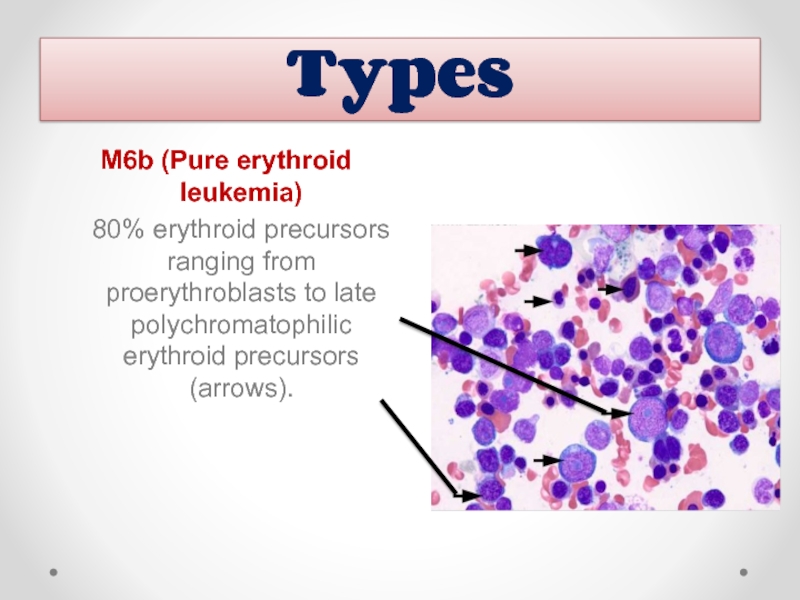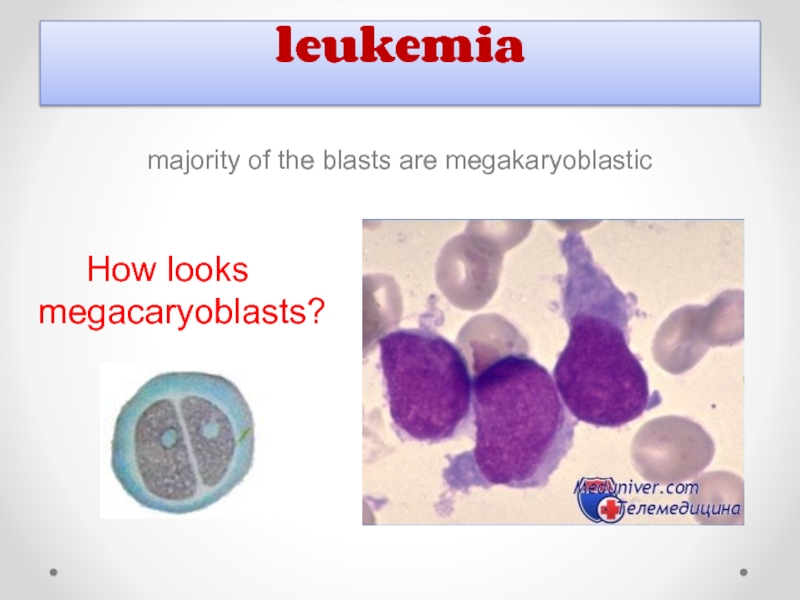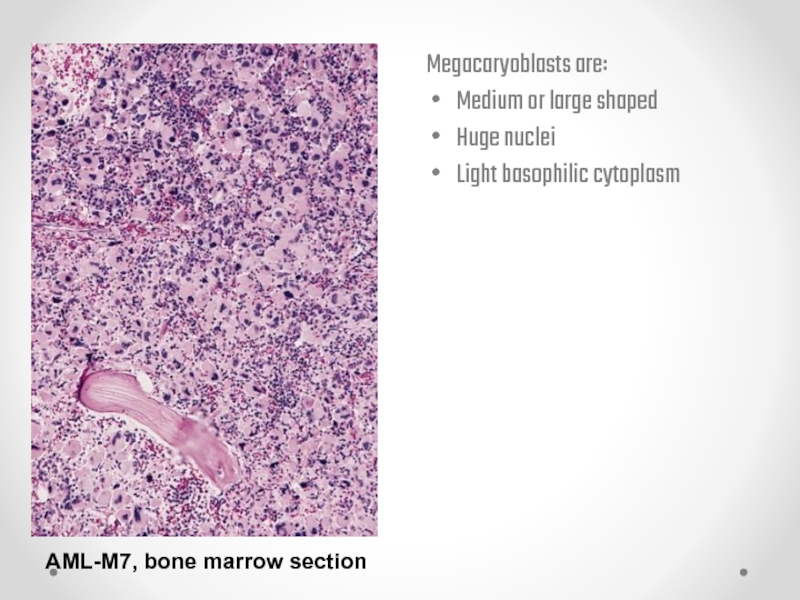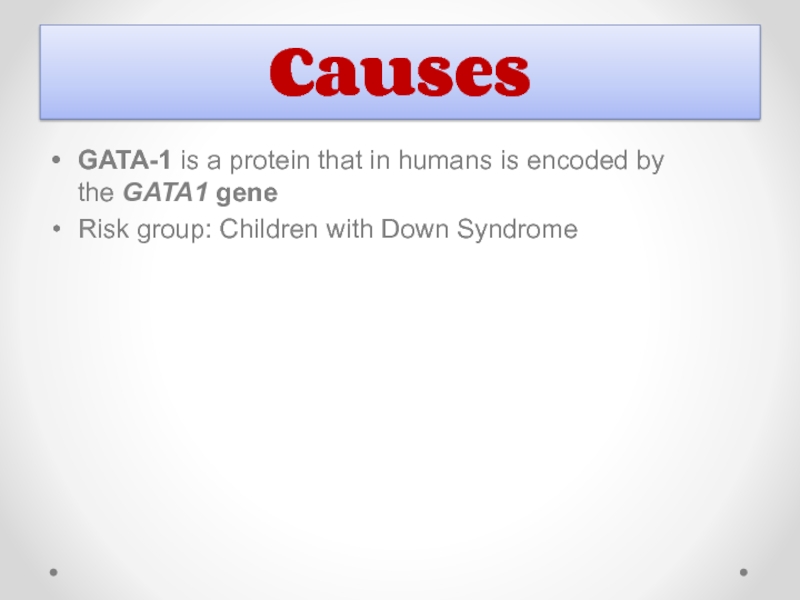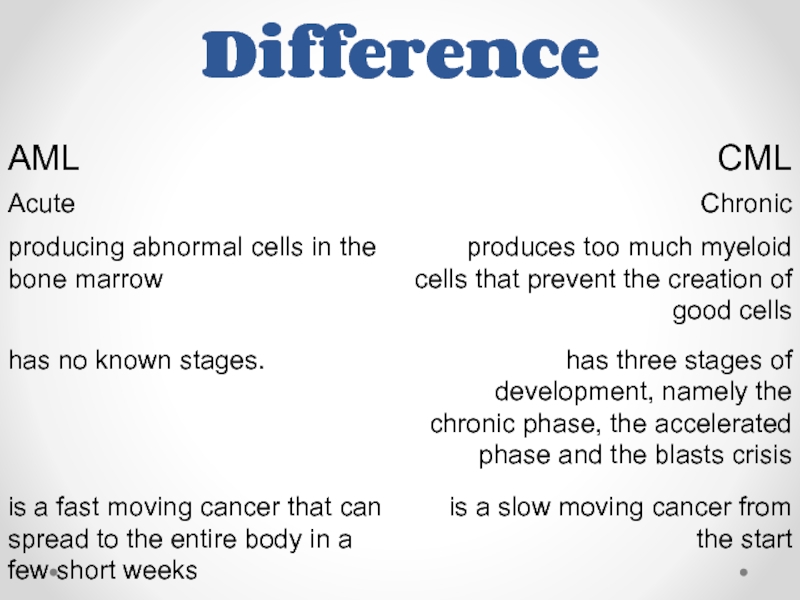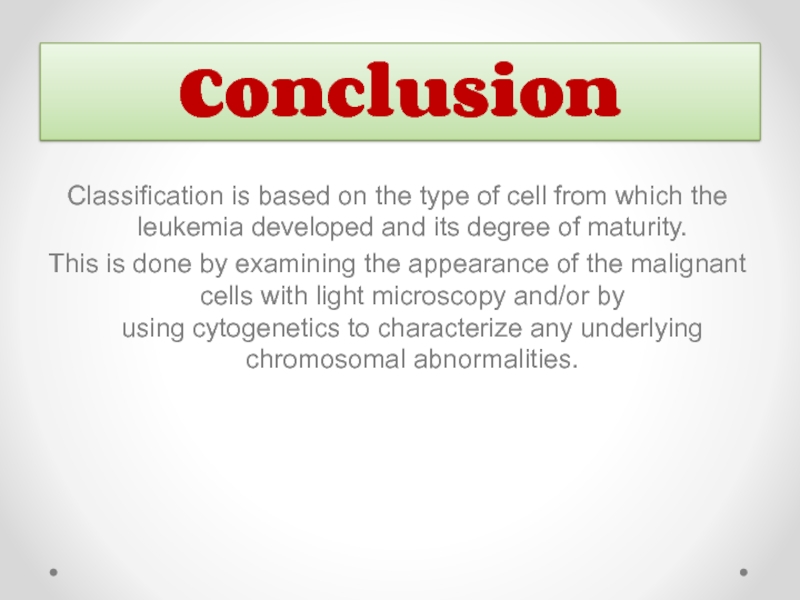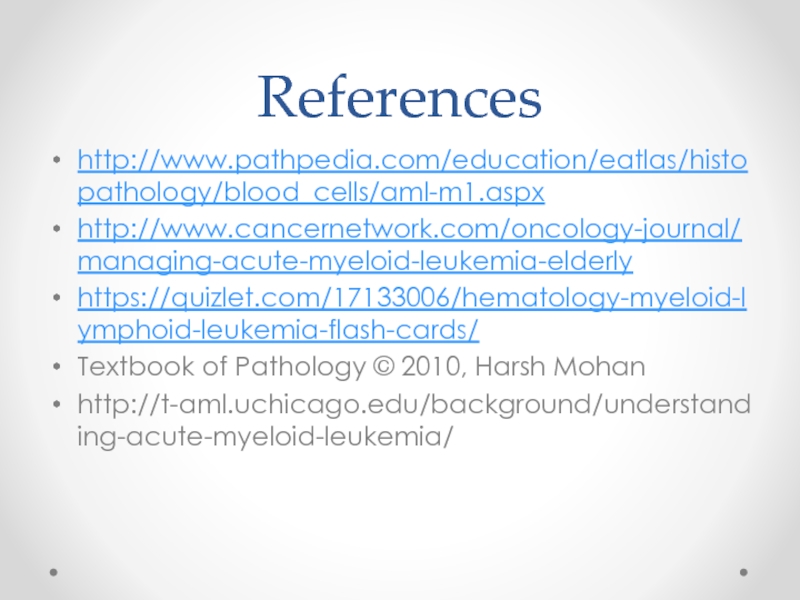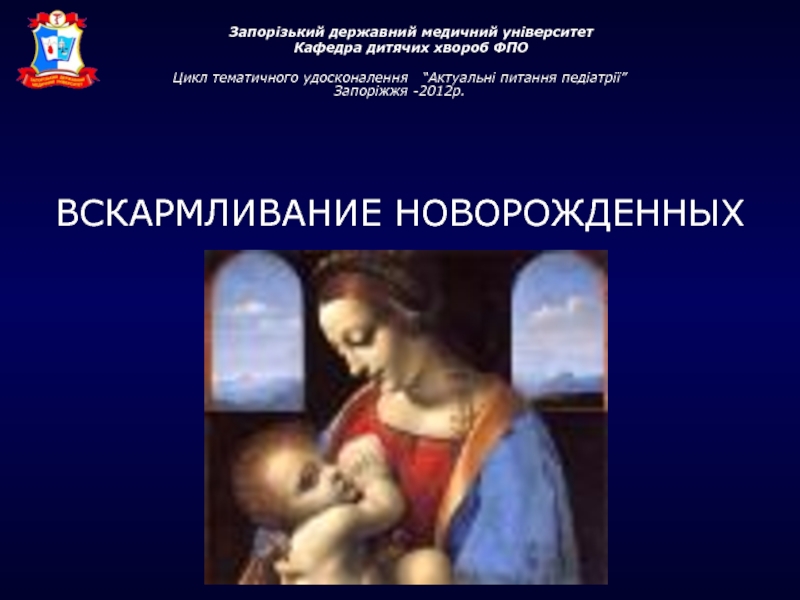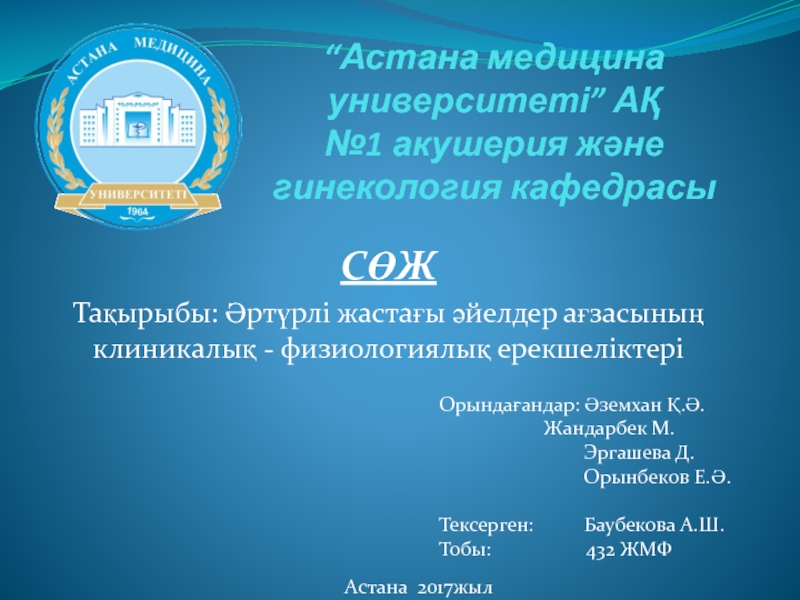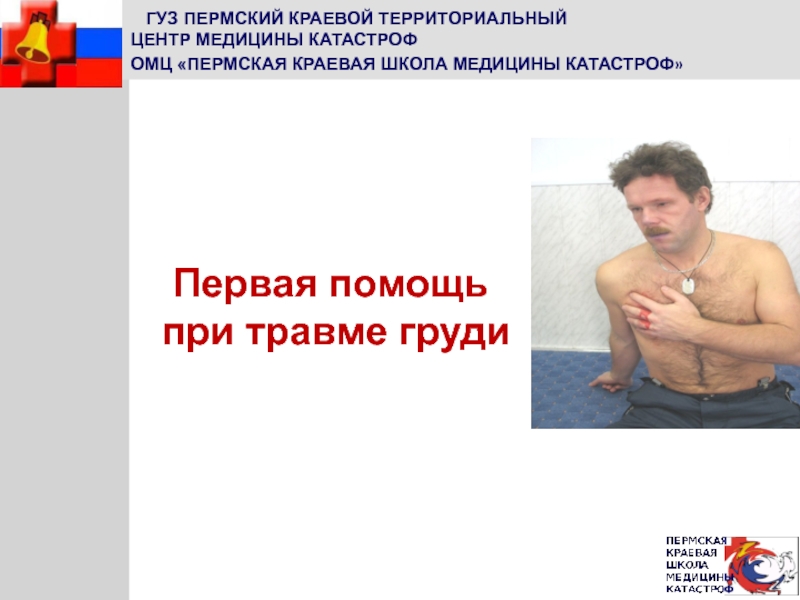by:
Head of department of Pathological Anatomy
Sapargaliyeva Aigul
- Главная
- Разное
- Дизайн
- Бизнес и предпринимательство
- Аналитика
- Образование
- Развлечения
- Красота и здоровье
- Финансы
- Государство
- Путешествия
- Спорт
- Недвижимость
- Армия
- Графика
- Культурология
- Еда и кулинария
- Лингвистика
- Английский язык
- Астрономия
- Алгебра
- Биология
- География
- Детские презентации
- Информатика
- История
- Литература
- Маркетинг
- Математика
- Медицина
- Менеджмент
- Музыка
- МХК
- Немецкий язык
- ОБЖ
- Обществознание
- Окружающий мир
- Педагогика
- Русский язык
- Технология
- Физика
- Философия
- Химия
- Шаблоны, картинки для презентаций
- Экология
- Экономика
- Юриспруденция
Acute myeloid leukemia презентация
Содержание
- 1. Acute myeloid leukemia
- 2. PLAN Introduction Pathogenesis Classification Types Conclusion
- 3. INTRODUCTION Acute myeloid leukemia (AML), also known
- 4. Pathogenesis
- 6. Modern classification schemes for AML recognize
- 7. Classification
- 10. M0-M3 This scheme takes into account the
- 11. Minimally differentiated acute myeloblastic leukemia(M0)
- 15. Acute myeloblastic leukemia without maturation(M1)
- 16. [ACUTE MYELOGENOUS LEUKEMIA, M1, BLOOD]. AML-M1 is
- 17. [ACUTE MYELOGENOUS LEUKEMIA, M1, BLOOD]. The defining
- 18. [ACUTE MYELOGENOUS LEUKEMIA, M1, BLOOD]. Multiple myeloblasts
- 19. Acute Myeloid Leukemia with Maturation (AML-M2)
- 23. Acute promyelocytic leukemia M3
- 24. [AML-M3]. Acute myelogenous leukemia, M3 type, also
- 25. [AML-M3].This photomicrograph shows another important morphologic feature
- 26. AML-M3. This image depicts another morphologic feature
- 27. AML-M3. Acute promyelocytic leukemia often shows cells
- 28. AML-M3. Although most cells may show the
- 29. M4-M7 Lineage of the leukemic blasts:
- 30. involves an uncontrolled proliferation of myeloblasts and monoblasts Acute
- 31. Acute monocytic leukemia Note the nuclear folds
- 32. Acute erythroid leukemia myeloproliferation is of erythroblastic precursors
- 33. M6b (Pure erythroid leukemia) 80%
- 34. Acute megacaryoblastic leukemia majority of the blasts
- 35. Diagnosis requires more than 20% Blasts in
- 36. AML-M7, bone marrow section Megacaryoblasts are:
- 37. Causes GATA-1 is a protein that in humans is
- 38. Difference
- 39. Classification is based on the type of
- 40. References http://www.pathpedia.com/education/eatlas/histopathology/blood_cells/aml-m1.aspx http://www.cancernetwork.com/oncology-journal/managing-acute-myeloid-leukemia-elderly https://quizlet.com/17133006/hematology-myeloid-lymphoid-leukemia-flash-cards/ Textbook of Pathology © 2010, Harsh Mohan http://t-aml.uchicago.edu/background/understanding-acute-myeloid-leukemia/
Слайд 1Acute myeloid leukemia
Department of Pathological Anatomy
Prepared by:
GM 14-24-2
Imangali Maira
Sotsialova Aidana
Checked
Слайд 3INTRODUCTION
Acute myeloid leukemia (AML),
also known as acute myelogenous leukemia or acute
nonlymphocytic leukemia (ANLL),
is a cancer of the myeloid line of blood cells, characterized by the rapid growth of abnormal white blood cells that accumulate in the bone marrow and interfere with the production of normal blood cells.
is a cancer of the myeloid line of blood cells, characterized by the rapid growth of abnormal white blood cells that accumulate in the bone marrow and interfere with the production of normal blood cells.
Слайд 6
Modern classification schemes for AML recognize the characteristics and behavior of
the leukemic cell (and the leukemia) may depend on the stage at which differentiation was halted.
Слайд 10M0-M3
This scheme takes into account the degree of maturation
M0 acute myeloblastic leukemia,
minimally differentiated 5%
M1 acute myeloblastic leukemia, without maturation 15%
M2 acute myeloblastic leukemia, with granulocytic maturation t(8;21)(q22;q22), t(6;9) 25%
M3 promyelocytic, or acute promyelocytic leukemia (APL) t(15;17) 10%
M1 acute myeloblastic leukemia, without maturation 15%
M2 acute myeloblastic leukemia, with granulocytic maturation t(8;21)(q22;q22), t(6;9) 25%
M3 promyelocytic, or acute promyelocytic leukemia (APL) t(15;17) 10%
Слайд 16[ACUTE MYELOGENOUS LEUKEMIA, M1, BLOOD]. AML-M1 is defined by presence of
more than 90% myeloblasts in blood and/or bone marrow and lack of any recurring chromosomal abnormalities such as t(8;21), t(15;17), inv(16) or t(16;16)(p13;q22). The distinction between AML-M1 and AML-M2 not otherwise specified can be arbitrary than real since it merely depends on the blast count. AML-M1 is also known as AML without maturation. Most blasts are large and typical of myeloblasts with prominent nucleoli.
Слайд 17[ACUTE MYELOGENOUS LEUKEMIA, M1, BLOOD]. The defining feature of a myeloblast
is fine nuclear chromatin and scant to moderate amount of cytoplasm. Note that myeloblasts may not show any cytoplasmic granules or Auer rods as in this case. The correct identification rests upon immunophenotyping which shows expression of myelomonocytic antigens such as CD13, CD15, CD33, CD117, and myeloperoxidase. The blasts generally also express CD34 and HLA-DR.
Слайд 18[ACUTE MYELOGENOUS LEUKEMIA, M1, BLOOD]. Multiple myeloblasts are shown with one
myeloblast containing several fine rods-like structures called Auer rods. Auer rods are only seen in acute leukemias of myeloid differentiation.
Слайд 24[AML-M3]. Acute myelogenous leukemia, M3 type, also known as acute promyelocytic.This
case illustrates hypergranular morphology with most cells containing abundant large granules (arrows). Note the lack of more mature myeloid elements, such as metamyelocytes, bands, and segmented neutrophils. Also note the lack of erythroid elements. Although most cases show Auer rods, this particular case did not contain any Auer rods. The lack of Auer rods is a rare but well documented finding. This case had t(15;17) in all 20 metaphase cells and was also positive for PML-RAR fusion transcript by FISH study.
Слайд 25[AML-M3].This photomicrograph shows another important morphologic feature of hypergranular type; specifically,
not only intact cells with abundant granulation are identified (arrow) but many ruptured cells are also seen releasing their granules free onto the slide (four arrowheads). The leukemic cells appear to be more fragile than normal promyelocytes and break apart upon smearing on the slides. In the absence of Auer rods, presence of abundant free large granules helps in differentiating leukemic promyelocytes from normal promyelocytes.
Слайд 26AML-M3. This image depicts another morphologic feature of acute promyelocytic leukemia,
that is, polarity of cytoplasmic granulation. In many cells the granules tend to polarize toward one portion of the cytoplasm and the nucleus on the opposite side (arrows). In normal promyelocytes the granules are distributed rather evenly throughout the cytoplasm and polarization is not a distinct and obvious feature. When cytoplasmic granulation is heavy and polarized it is a good telltale morphologic sign of acute promyelocytic leukemia in the appropriate clinical context.
Слайд 27AML-M3. Acute promyelocytic leukemia often shows cells having dumbbell shaped or
convoluted nuclear lobes (arrows). This feature is more common with hypogranular/microgranular form than hypergranular type but a few cells can usually be found in the hypergranular type as well. Normal promyelocytes DO NOT have dumbbell shaped or convoluted nuclear lobes.
Слайд 28AML-M3. Although most cells may show the hypergranular morphology (arrow), some
cells can have a hypogranular/microgranular or typical blast morphology with fewer and finer granules and fine chromatin (curved arrows). When most cells show typical blast morphology, distinction from other acute myelogenous leukemia is difficult and the final diagnosis rests upon demonstration of the typical t(15;17) or positive FISH result for PML-RAR
Слайд 29M4-M7
Lineage of the leukemic blasts:
M4 acute myelomonocytic leukemia inv(16)(p13q22), del(16q) 20%
M4eo myelomonocytic together with bone
marrow eosinophilia inv(16), t(16;16) 5%
M5 acute monoblastic leukemia (M5a) or acute monocytic leukemia (M5b) del (11q), t(9;11), t(11;19) 10%
M6 acute erythroid leukemias, including erythroleukemia (M6a) and very rare pure erythroid leukemia (M6b) 5%
M7 acute megakaryoblastic leukemia t(1;22) 5%
M5 acute monoblastic leukemia (M5a) or acute monocytic leukemia (M5b) del (11q), t(9;11), t(11;19) 10%
M6 acute erythroid leukemias, including erythroleukemia (M6a) and very rare pure erythroid leukemia (M6b) 5%
M7 acute megakaryoblastic leukemia t(1;22) 5%
Слайд 30involves an uncontrolled proliferation of myeloblasts and monoblasts
Acute myelomonocytic leukemia
More than 20% of
the non-erythroid cells are monoblasts.
Monoblasts (like their mature counterpart, monocytes) have convoluted nuclei (A).
Monoblasts (like their mature counterpart, monocytes) have convoluted nuclei (A).
Слайд 31Acute monocytic leukemia
Note the nuclear folds and the relatively large nucleoli
typical of monoblasts at right.
blast cells in the bone marrow and blood precursors are represented essentially by monocytes.
Слайд 33M6b (Pure erythroid leukemia)
80% erythroid precursors ranging from proerythroblasts
to late polychromatophilic erythroid precursors (arrows).
Types
Слайд 34Acute megacaryoblastic leukemia
majority of the blasts are megakaryoblastic
How looks
megacaryoblasts?
Слайд 35 Diagnosis requires more than 20% Blasts in the marrow/ peripheral blood
with more than 50% demonstrating megakaryocytic derivation by morphology
20%
50%
Слайд 36AML-M7, bone marrow section
Megacaryoblasts are:
Medium or large shaped
Huge nuclei
Light
basophilic cytoplasm
Слайд 37Causes
GATA-1 is a protein that in humans is encoded by the GATA1 gene
Risk group: Children
with Down Syndrome
Слайд 39Classification is based on the type of cell from which the
leukemia developed and its degree of maturity.
This is done by examining the appearance of the malignant cells with light microscopy and/or by using cytogenetics to characterize any underlying chromosomal abnormalities.
This is done by examining the appearance of the malignant cells with light microscopy and/or by using cytogenetics to characterize any underlying chromosomal abnormalities.
Conclusion
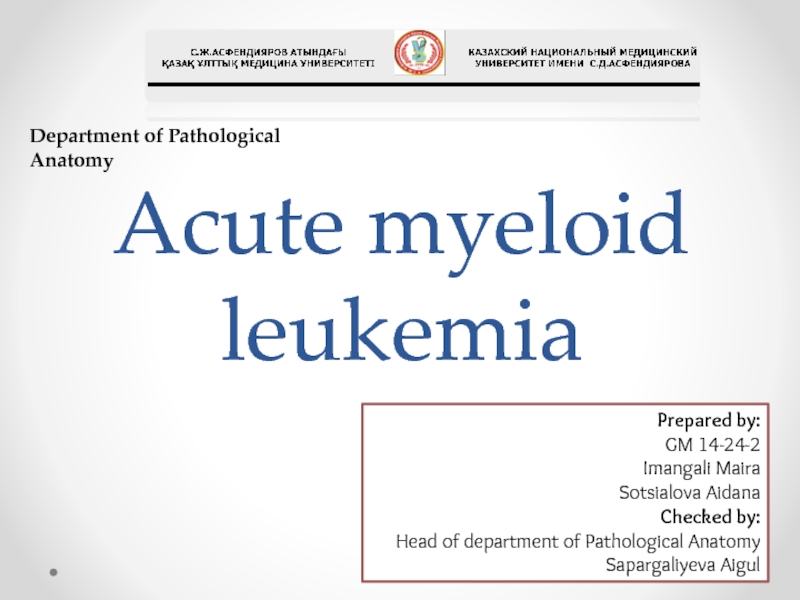

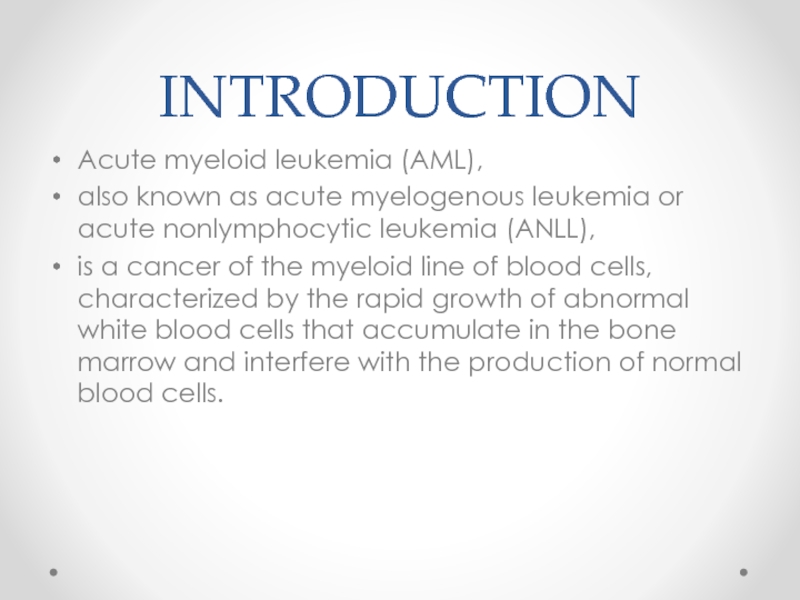

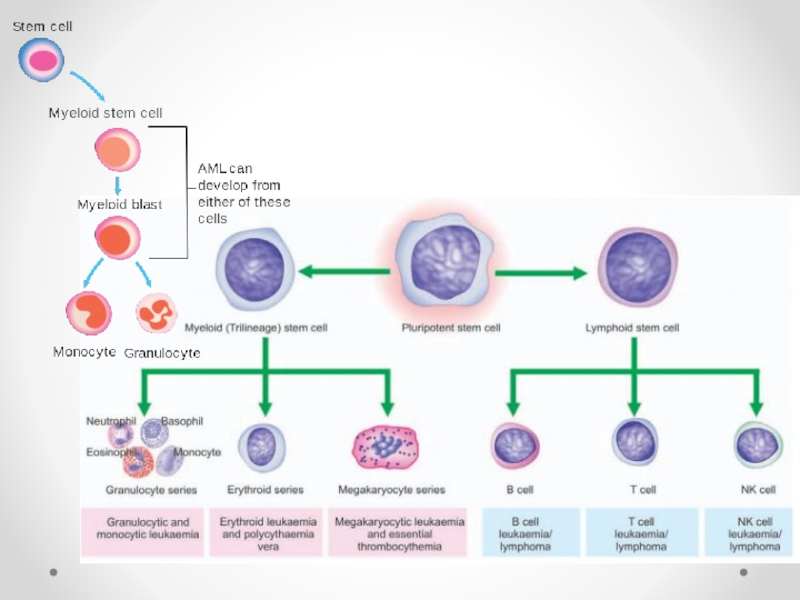
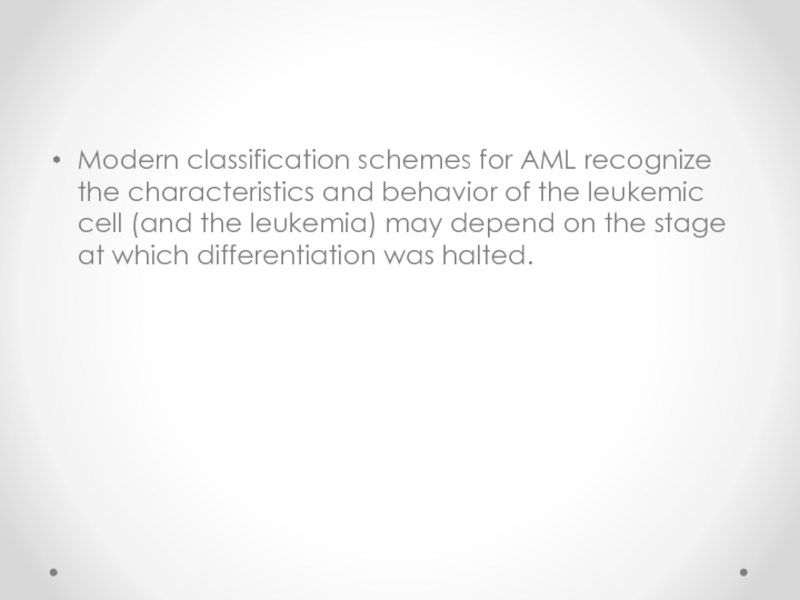
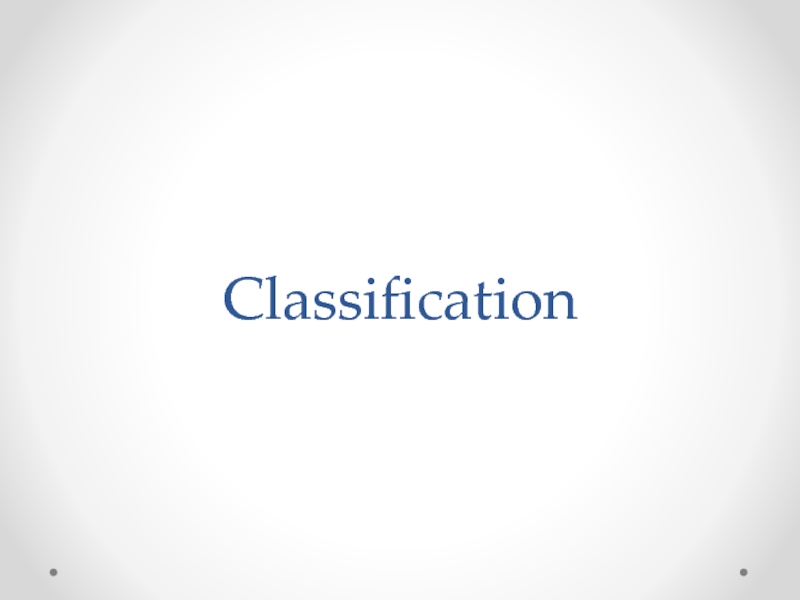
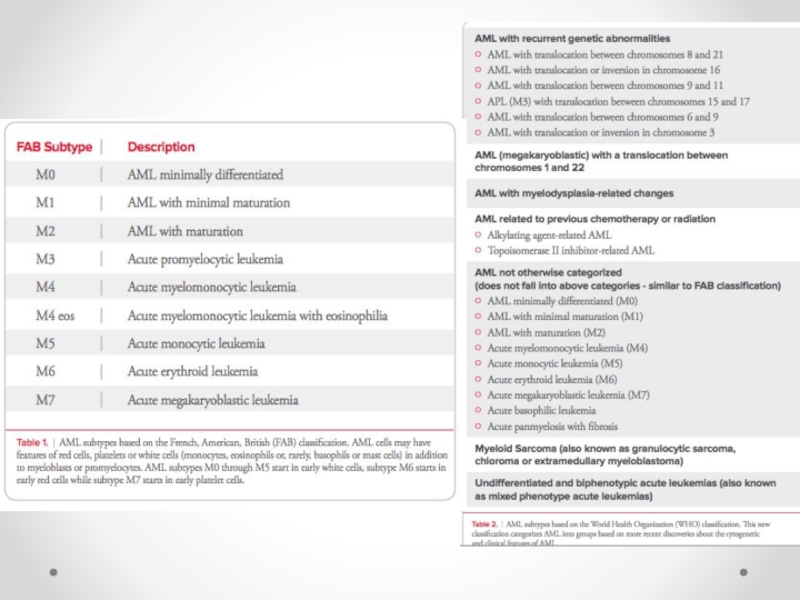
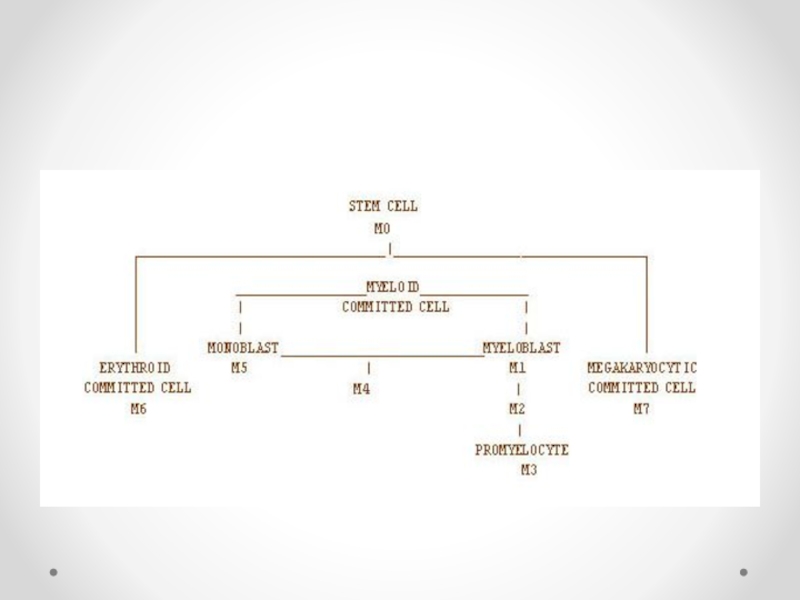
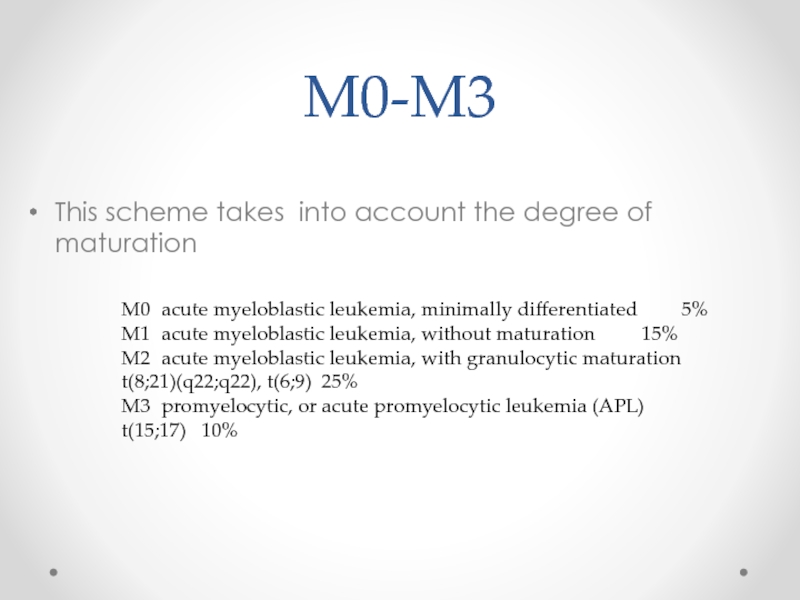
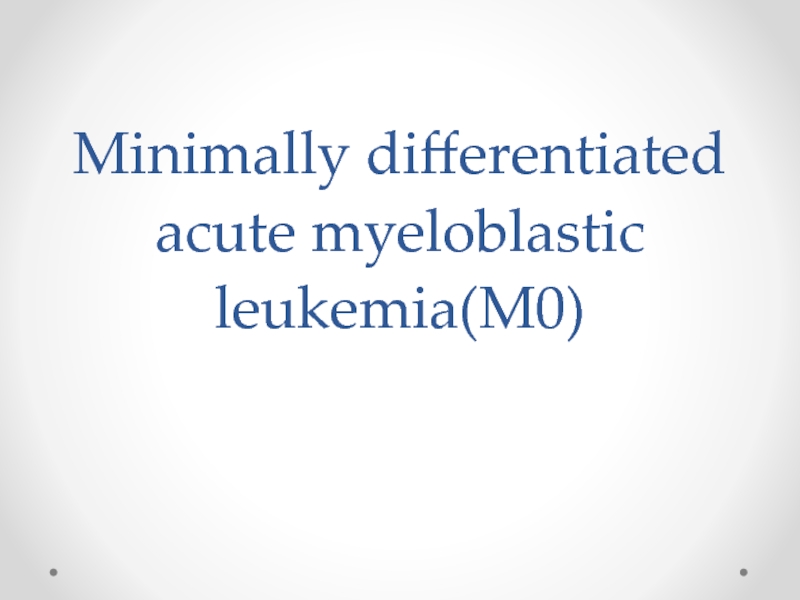
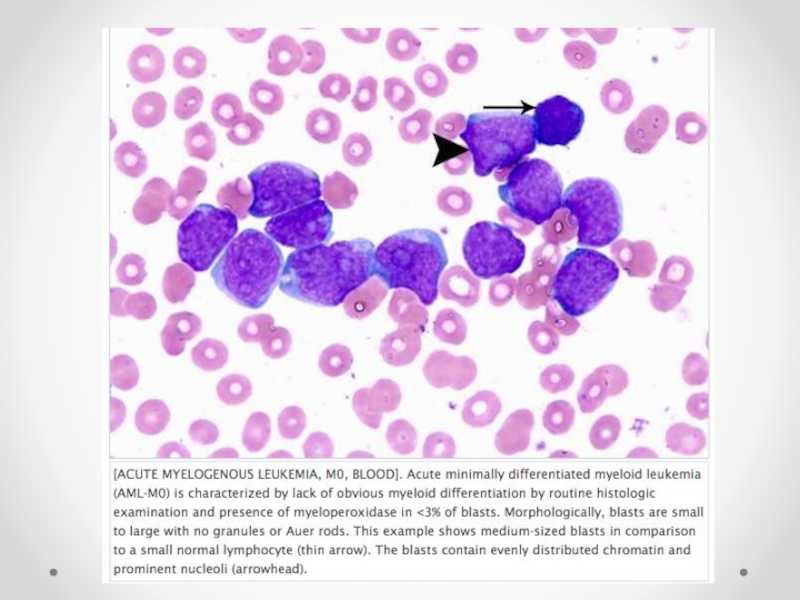
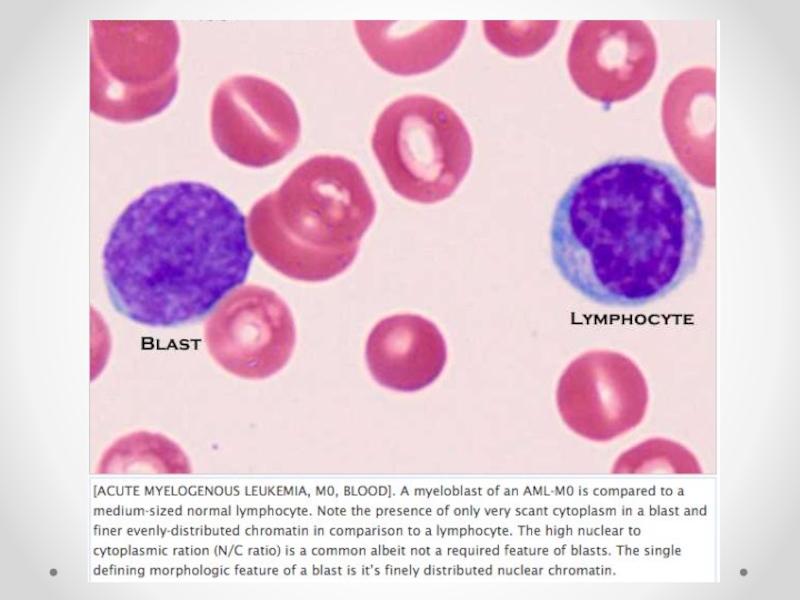
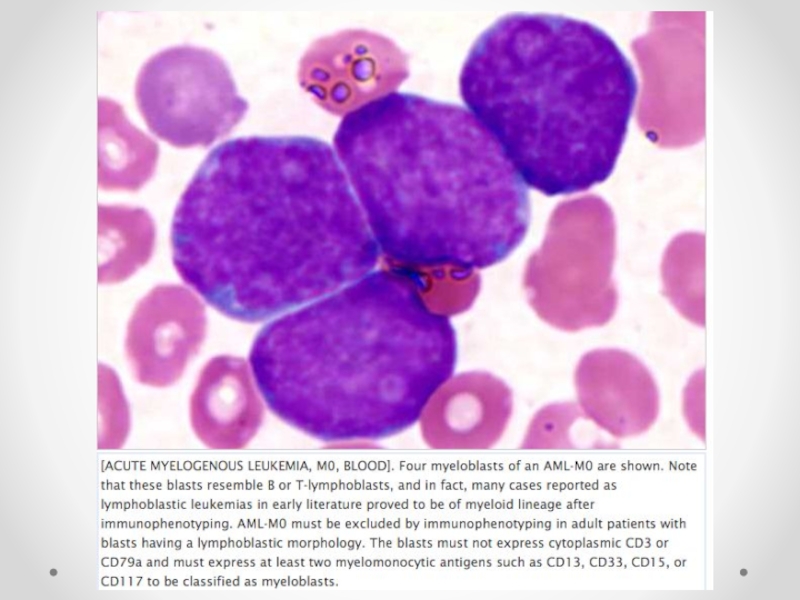
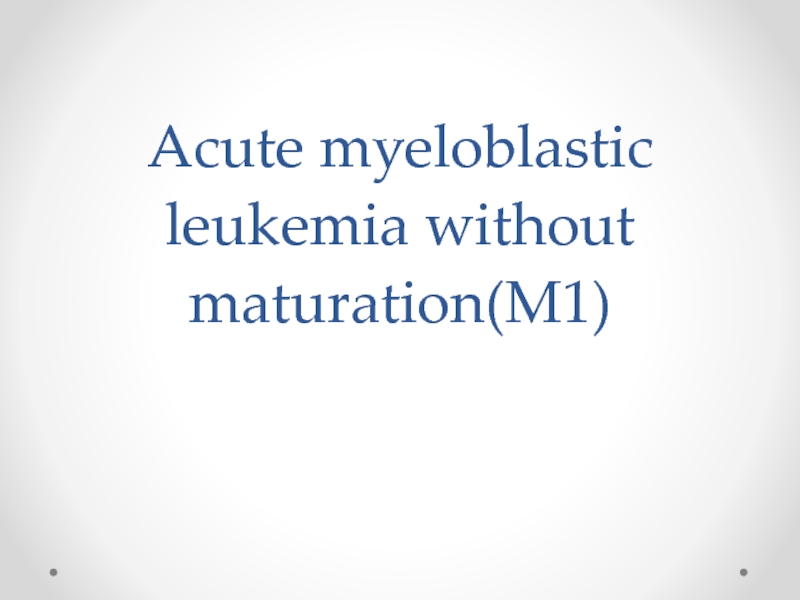
![[ACUTE MYELOGENOUS LEUKEMIA, M1, BLOOD]. AML-M1 is defined by presence of more than 90% myeloblasts](/img/tmb/4/362992/51d2dbd8a4cd21ada7308020955af5e8-800x.jpg)
![[ACUTE MYELOGENOUS LEUKEMIA, M1, BLOOD]. The defining feature of a myeloblast is fine nuclear chromatin](/img/tmb/4/362992/aea6720278d6578e08afe8e1505ae4a7-800x.jpg)
![[ACUTE MYELOGENOUS LEUKEMIA, M1, BLOOD]. Multiple myeloblasts are shown with one myeloblast containing several fine](/img/tmb/4/362992/f4e8460c9479e78a6b4b09d720e9457b-800x.jpg)

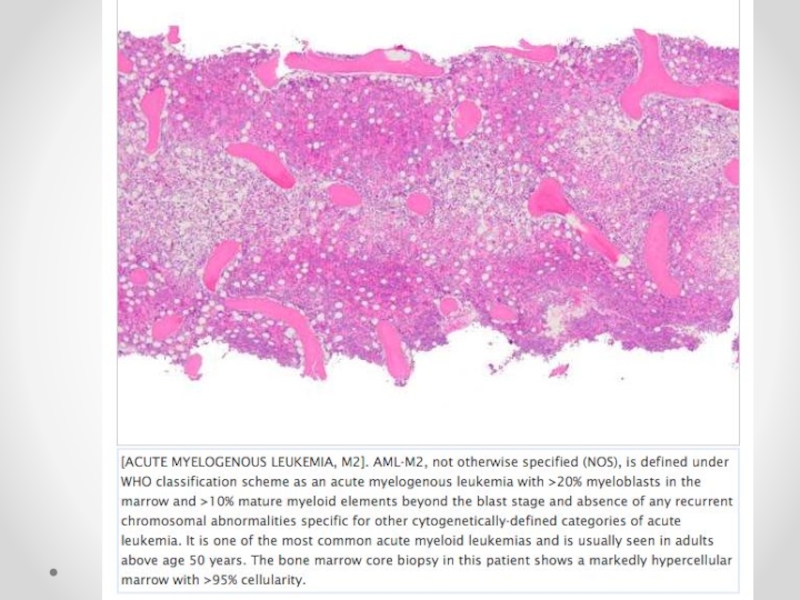
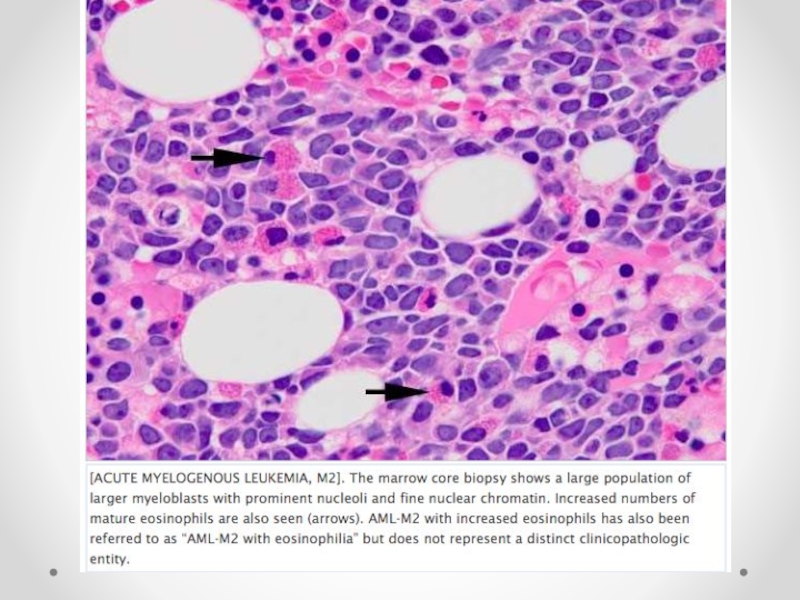
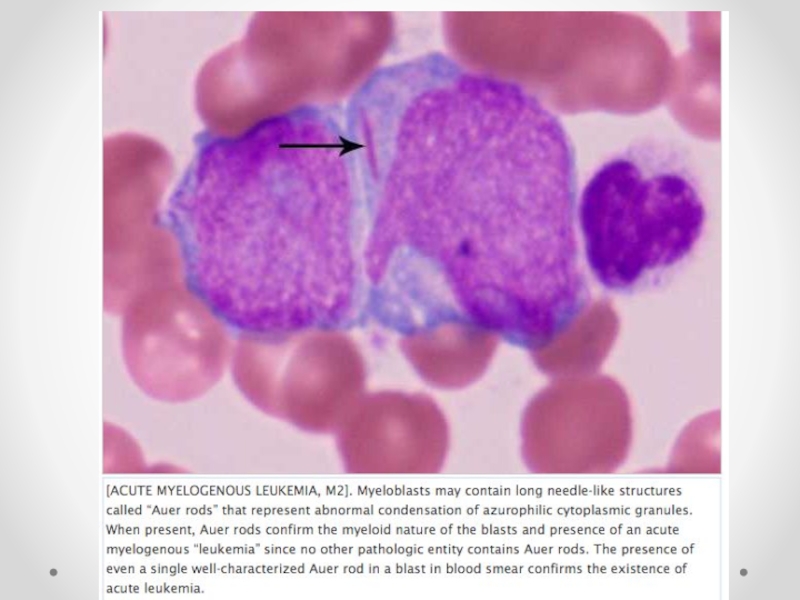
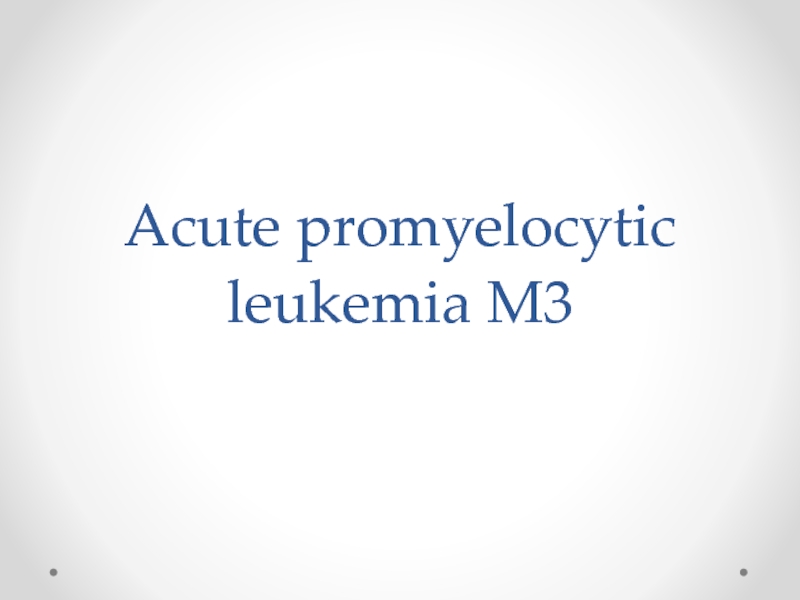
![[AML-M3]. Acute myelogenous leukemia, M3 type, also known as acute promyelocytic.This case illustrates hypergranular morphology](/img/tmb/4/362992/7136e4d1079b9895b9b6e29e57933919-800x.jpg)
![[AML-M3].This photomicrograph shows another important morphologic feature of hypergranular type; specifically, not only intact cells](/img/tmb/4/362992/f0c22889a48195a8aeb31886baa75a92-800x.jpg)
